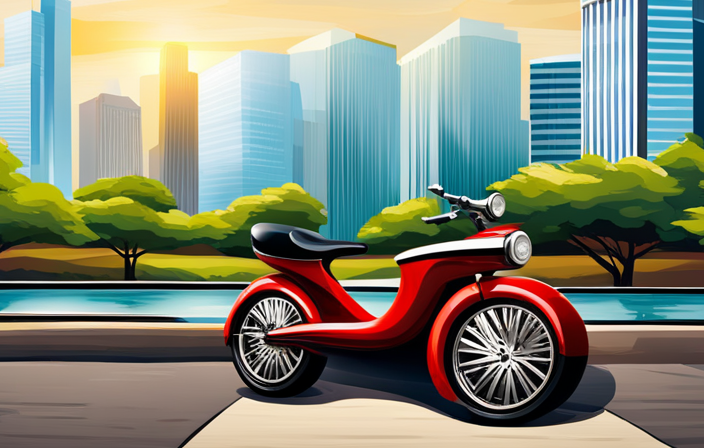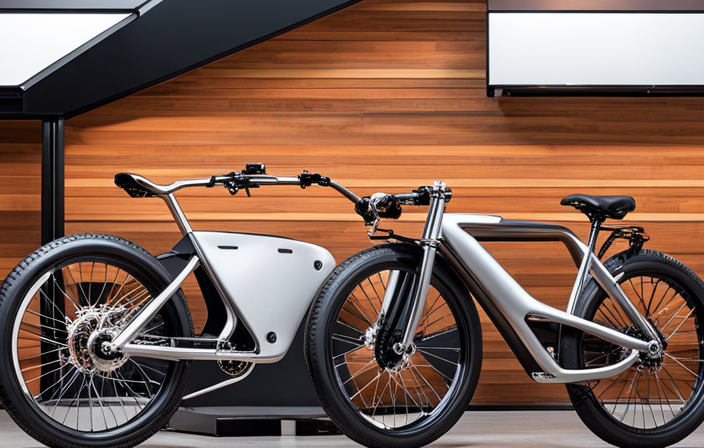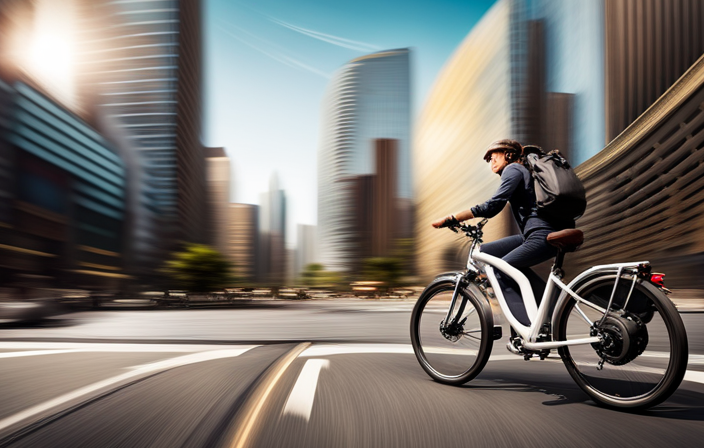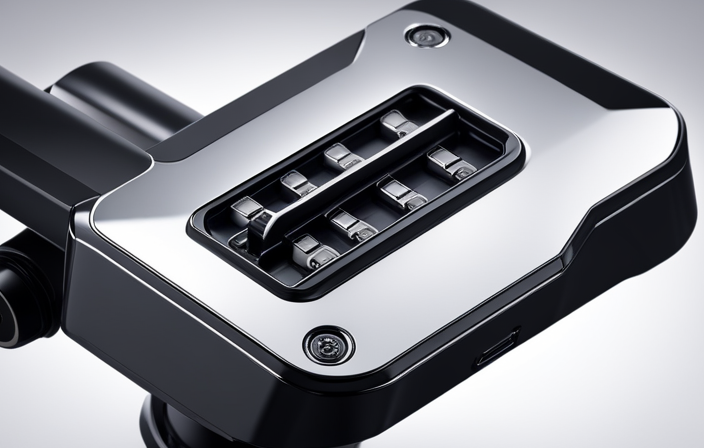Imagine this: the breeze in your hair, the sense of liberation as you smoothly cruise through urban roads, and the fulfillment of knowing you’re minimizing your carbon footprint. All of this is achievable with an electric bicycle.
But how much will it cost? In this article, I’ll explore the various factors that affect electric bike prices and guide you through the different options available.
So, whether you’re a budget-conscious commuter or in search of a high-performance ride, let’s find the perfect electric bike for you.
Key Takeaways
- The price of an electric bike is influenced by factors such as the type of motor, battery capacity, additional features, and the quality of components.
- Entry-level electric bikes like the Ancheer Power Plus and Swagtron EB-5 Pro offer an affordable and accessible option for beginners, with decent range and power for various terrains.
- Mid-range electric bikes provide a seamless upgrade from entry-level bikes, offering enhanced features, improved handling, and a battery range of 40-80 miles.
- High-end electric bikes, priced from $3,000 to over $10,000, offer advanced technology, powerful motors, exceptional quality, durability, and a luxurious riding experience.
Types of Electric Bikes
So, if you’re interested in electric bikes, let’s talk about the different types you can choose from.
There are several types of electric bikes available in the market, each catering to different needs and preferences.
The first type is the commuter electric bike, designed for daily city commuting. These bikes usually have a lightweight frame, comfortable seating, and features like mudguards and lights for safety.
The second type is the mountain electric bike, built for off-road adventures. These bikes have robust frames, powerful motors, and wide tires with excellent traction.
The third type is the folding electric bike, perfect for those who need a compact and portable option for commuting or traveling. These bikes are lightweight, easy to fold, and can be stored in small spaces.
Electric bike maintenance and safety are important considerations for all types of electric bikes, ensuring smooth rides and longevity.
Now, let’s discuss the factors affecting electric bike prices.
Factors Affecting Electric Bike Prices
Interested in purchasing an e-bike? Let’s explore the various factors that influence their price.
When it comes to electric bikes, there are a few key factors that can greatly affect the cost.
-
Types of Motors: The type of motor used in an electric bike can have a significant impact on its price. High-performance motors, such as mid-drive motors, tend to be more expensive compared to hub motors.
-
Battery Capacity: The capacity of the battery is another important factor to consider. E-bikes with larger battery capacities generally have a higher price tag. A larger battery allows for longer rides and more power.
-
Additional Features: Certain additional features, like advanced suspension systems or high-quality components, can also drive up the price of an electric bike.
By understanding these factors, you can make an informed decision when purchasing your e-bike.
In the next section, we will explore the world of entry-level electric bikes.
Entry-Level Electric Bikes
If you’re just starting out in the world of e-bikes, entry-level options are like a gateway to an exhilarating and eco-friendly adventure. These entry-level electric bikes are designed to provide an accessible and affordable option for those who want to experience the joy of electric biking without breaking the bank.
When it comes to the best entry-level electric bikes, there are a few standout options that offer a perfect balance between price and performance. Models like the Ancheer Power Plus and the Swagtron EB-5 Pro are known for their reliability, durability, and user-friendly features. These bikes typically offer a decent range, a comfortable riding experience, and enough power to tackle hills and rough terrains.
As you gain more experience and confidence, you can easily transition to the next level of electric bikes, the mid-range electric bikes, which offer even more advanced features and capabilities.
Mid-Range Electric Bikes
With enhanced features and improved capabilities, mid-range e-bikes provide a seamless transition for riders looking to upgrade their cycling experience. These bikes are equipped with different types of motors, such as hub motors or mid-drive motors, each offering its own advantages.
Hub motors are typically found in rear wheels and provide a smooth and quiet ride, while mid-drive motors are integrated into the bike’s frame and offer better handling and balance.
When it comes to battery life, mid-range e-bikes usually have a range of around 40-80 miles, depending on factors like terrain, rider weight, and assist level. This ensures that riders can enjoy longer rides without worrying about running out of power.
As we move towards the discussion about high-end electric bikes, it’s important to note that these mid-range options already provide a significant upgrade in performance and features.
High-End Electric Bikes
When it comes to high-end electric bikes, the price range can vary significantly. These bikes often come with a hefty price tag, ranging from $3,000 to over $10,000. The cost depends on factors such as battery capacity, motor power, and advanced features like suspension systems and smart connectivity. Many buyers often wonder, how much is an electric dirt bike, as off-road models can be even more expensive due to their rugged design and high-performance components. Ultimately, the right choice depends on individual needs and budget constraints.
However, the features and performance of these bikes are top-notch, with advanced technology, powerful motors, and long-lasting batteries.
While the price may be a drawback for some, the pros of high-end electric bikes include exceptional quality, durability, and a luxurious riding experience.
Price Range
The price range for an electric bike varies depending on the brand and features. There are several factors that can affect the price of an electric bike, such as the quality of the components, the power of the motor, and the overall design and construction.
High-end electric bikes tend to have a higher price tag due to their superior performance and advanced features. However, there are also electric bikes available at different price points that offer great value for money. These bikes may have slightly less powerful motors or fewer advanced features, but they still provide a reliable and enjoyable ride.
Moving on to the next section about features, it’s important to consider what specific features you are looking for in an electric bike.
Features
Let’s explore the impressive features that make these e-bikes stand out from the rest. Electric bike features are designed to enhance the overall riding experience and provide numerous benefits.
- Power-assisted pedaling: Electric bikes offer the advantage of power-assisted pedaling, allowing riders to effortlessly tackle steep hills and long distances.
- Multiple riding modes: With various riding modes such as eco, normal, and sport, electric bikes provide flexibility and adaptability to different terrains and preferences.
- Extended battery life: Modern electric bikes come with advanced battery technology, offering longer rides without worrying about running out of power.
These features contribute to the immense popularity of electric bikes. The benefits of electric bikes include reduced effort during rides, improved fitness levels, and reduced carbon emissions. However, it’s important to consider the pros and cons before making a decision.
Pros and Cons
One can’t deny the advantages and drawbacks of these innovative rides. Electric bikes, also known as e-bikes, offer numerous benefits that make them a popular choice among commuters and outdoor enthusiasts. On the positive side, electric bikes provide an eco-friendly mode of transportation, reducing carbon emissions and promoting sustainability. They also offer a convenient and efficient way to travel, especially in congested urban areas. Additionally, e-bikes can assist riders in tackling challenging terrains or steep hills, making them suitable for riders of all fitness levels. However, it’s important to consider the cons as well. Electric bikes tend to be more expensive than traditional bicycles, and their battery life may limit the distance one can travel on a single charge. Furthermore, the added weight of the battery and motor can make the bike heavier and harder to maneuver. Despite these drawbacks, the benefits of electric bikes make them a compelling option for many riders. Moving on to the next section about used and refurbished electric bikes, it’s worth exploring the potential cost savings and considerations when purchasing these alternatives.
Used and Refurbished Electric Bikes
Looking to save some cash? Score a used or refurbished electric bike and watch your wallet cry tears of joy! The used electric bike market offers a wide variety of options at a fraction of the cost of a brand new bike.
Here are some advantages of buying a refurbished electric bike:
-
Cost-effective: Used electric bikes are significantly cheaper than their brand new counterparts, allowing you to save money without compromising on quality.
-
Environmental impact: By purchasing a used electric bike, you are giving new life to an existing product, reducing waste and minimizing the carbon footprint associated with manufacturing.
-
Higher-end models within reach: With a limited budget, you may not be able to afford a top-of-the-line electric bike. However, in the used market, you can find higher-end models that were previously out of your price range.
-
Proven performance: Refurbished electric bikes have been tested and proven to perform well, giving you peace of mind that you are getting a reliable and functioning bike.
-
Customization options: Buying used allows you to find unique models and customize them to your liking, giving you a one-of-a-kind electric bike experience.
Transitioning into the subsequent section about electric bike accessories, you’ll find a wide range of options to enhance your riding experience.
Electric Bike Accessories
Now that we have discussed used and refurbished electric bikes, let’s delve into the world of electric bike accessories.
These additional add-ons can greatly enhance your riding experience and make your electric bike even more convenient and enjoyable to use. Electric bike accessories can include items such as panniers and baskets for carrying groceries or gear, fenders to keep you dry on rainy days, and lights for increased visibility at night. Additionally, there are accessories like phone mounts, bells, and mirrors that can improve your safety and convenience while riding.
When it comes to maintaining your electric bike and its accessories, it’s important to regularly check and tighten any bolts, clean and lubricate the chain, and keep your tires properly inflated. By taking these simple maintenance tips into consideration, you can ensure that your electric bike and its accessories are always in top shape and ready for your next adventure.
Now, let’s move on to the next section where we will discuss maintenance and repairs for electric bikes.
Maintenance and Repairs
When it comes to maintaining and repairing an electric bike, there are several key points to consider.
First and foremost, taking care of the battery is crucial for optimal performance and longevity.
Regularly checking tire pressure and ensuring proper tread depth is important for safety and a smooth ride.
Brake maintenance is essential for reliable stopping power, and regular cleaning helps prevent dirt and debris from affecting the bike’s components.
Lastly, conducting regular inspections to identify any potential issues before they become major problems is a great way to keep your electric bike running smoothly.
Battery Care
Proper battery care is essential to ensure the longevity and optimal performance of your electric bike. When it comes to battery charging, it is important to follow the manufacturer’s instructions. Overcharging or undercharging can affect the battery lifespan.
It is recommended to charge the battery fully before each ride and avoid partial charging as it can lead to decreased battery capacity over time. Additionally, it is advisable to store the battery in a cool and dry place when not in use, as extreme temperatures can negatively impact its performance.
Regularly inspect the battery for any signs of damage or wear, and if necessary, consult a professional for repairs or replacements. Taking these precautions will help maintain the health of your electric bike’s battery and ensure a smooth and reliable ride.
Speaking of maintenance, let’s now move on to tire maintenance and how to keep your electric bike running smoothly.
Tire Maintenance
To ensure optimal performance and longevity, it is essential to properly maintain the tires of your e-bike. One key aspect of tire maintenance is maintaining the correct tire pressure. This not only improves the overall ride quality but also enhances the efficiency of your electric bike. It is important to check the tire pressure regularly and inflate or deflate them as needed. Additionally, keeping the tires at the recommended pressure helps to prevent premature wear and tear, ensuring a longer tire lifespan.
In order to convey a deeper understanding, here is a table outlining the recommended tire pressure for different types of e-bikes:
| E-Bike Type | Tire Pressure (psi) |
|---|---|
| City E-Bike | 40-60 |
| Mountain E-Bike | 30-50 |
| Road E-Bike | 60-80 |
Proper tire maintenance is crucial for a safe and enjoyable ride. Next, we will discuss brake maintenance and its importance in ensuring your e-bike’s overall performance.
Brake Maintenance
Brake maintenance is crucial for ensuring your e-bike performs at its best. Did you know that a study found that 22% of accidents involving bicycles are caused by brake failure? To prevent such mishaps, regular brake adjustment and brake pad replacement are essential.
Here are four important steps to keep your brakes in top condition:
-
Check brake pad wear: Inspect the brake pads regularly and replace them if they are worn down to the recommended limit.
-
Adjust brake cable tension: Ensure the brake cables are properly tensioned to provide optimal braking power.
-
Align brake calipers: Make sure the brake calipers are properly aligned with the rim to ensure even brake pad contact.
-
Test brake performance: After any adjustment or replacement, test the brakes to ensure they are responding effectively.
By following these steps, you can maintain your e-bike’s brakes and ride with confidence.
Now, let’s move on to the next section about cleaning and keeping your bike in pristine condition.
Cleaning
Make sure you take the time to give your e-bike a thorough cleaning, removing any dirt and grime that may have accumulated on the frame and components. Cleaning your electric bike not only keeps it looking good, but also helps maintain its performance and longevity.
Here are some cleaning tips to keep in mind.
Firstly, use a gentle brush or sponge to scrub away any dirt or mud from the frame. Be sure to pay attention to hard-to-reach areas such as the chainring, cassette, and derailleur.
Secondly, use a mild soap or bike-specific cleaner to wash the bike. Avoid using harsh chemicals as they can damage the paint and components.
Lastly, make sure to dry the bike thoroughly using a soft cloth or air compressor.
When it comes to cleaning products, there are many options available in the market. Look for bike-specific cleaners that are designed to remove dirt and grime without damaging the bike.
Regular inspections are essential to ensure the safety and performance of your e-bike.
Regular Inspections
Regular inspections are crucial for keeping your e-bike running smoothly and ensuring your safety on the road. It is recommended to schedule regular inspections every 3-6 months, depending on your riding habits and the overall condition of your bike.
During these inspections, it is important to check the brakes, tires, and lights for any signs of wear or damage. Additionally, inspect the chain, gears, and battery connections to ensure they are functioning properly. Common maintenance issues that may arise include loose or worn-out components, damaged cables, and dirty or clogged drivetrains.
By addressing these issues promptly, you can prevent more serious problems from occurring and extend the lifespan of your e-bike.
Transitioning into the subsequent section about ‘diy repairs’, it is important to have a basic understanding of your e-bike’s mechanics to perform some of these repairs yourself.
DIY Repairs
Taking care of your own e-bike repairs can be a rewarding and empowering experience, allowing you to confidently tackle any issues that may arise. When it comes to DIY repairs, one important aspect to consider is battery care. Here are four key points to keep in mind:
- Regularly inspect your battery for any signs of damage or wear.
- Clean the battery terminals and connections to ensure a good electrical connection.
- Follow the manufacturer’s guidelines for charging and storing the battery.
- If you encounter any issues with the battery, such as a decrease in performance or reduced range, consult the user manual or reach out to the manufacturer for troubleshooting steps.
By properly maintaining your e-bike battery through DIY repairs, you can extend its lifespan and optimize its performance. However, for more complex repairs or if you are unsure about handling certain issues, it’s always advisable to seek professional assistance.
Professional Repairs
If you’re not confident in your own repair skills, it’s always a good idea to seek professional assistance for any complex issues with your e-bike. Professional repair costs for electric bikes can vary depending on the type of repair needed and the specific service provider.
It’s important to do your research and find reputable repair services that have experience working with electric bikes. Look for shops or technicians that specialize in e-bikes, as they will have the knowledge and expertise to properly diagnose and fix any issues. You can ask for recommendations from other e-bike owners or check online forums for reviews.
When considering the cost of professional repairs, keep in mind that it may be more expensive than DIY repairs, but it can save you time and ensure that the job is done correctly.
Transitioning into the subsequent section about ‘tips for buying an electric bike,’ it’s important to consider the cost of professional repairs as part of your overall budget.
Tips for Buying an Electric Bike
When purchasing an electric bike, it’s crucial to consider these helpful tips. First and foremost, you should research and understand the different types of batteries available for electric bikes. The most common ones are lithium-ion and lead-acid batteries. While lithium-ion batteries are lighter and have a longer lifespan, lead-acid batteries are more affordable. Additionally, make sure to inquire about the maintenance tips for the specific electric bike you are interested in. Regular maintenance such as keeping the battery charged and clean, checking the tire pressure, and lubricating the chain will ensure optimal performance and longevity of your electric bike. With these tips in mind, you’ll be well-equipped to make an informed decision when purchasing an electric bike. Speaking of purchasing, let’s now explore the financing options available for electric bikes.
Financing Options
When considering financing options for purchasing an electric bike, there are several key points to keep in mind.
Firstly, paying in full is always an option if you have the funds readily available. However, if you prefer to spread out the cost, many retailers offer installment plans or store financing options.
Additionally, using a credit card or taking out a personal loan are other viable options to consider.
Paying in Full
To get your hands on an electric bike, you can simply fork over the full payment and envision yourself cruising effortlessly through city streets. Paying in full is a great option if you have the means to do so. By paying upfront, you eliminate the need for installment plans or financing options, which can come with added interest and fees.
Additionally, paying in full allows you to own the bike outright from the start, without any financial obligations hanging over your head. It gives you the freedom to use the bike as you please, without worrying about monthly payments or credit checks.
However, if paying in full is not feasible for you, don’t worry. There are also installment plans available that can make owning an electric bike more manageable.
Installment Plans
By choosing an installment plan, you can pedal away on your dream ride while making regular payments that fit comfortably within your budget. Installment plans are a great way to afford an electric bike without having to pay the full amount upfront. With financing options available, you can break down the cost of the bike into manageable monthly payments. This allows you to enjoy the benefits of an electric bike while spreading out the financial commitment.
When considering installment plans, it’s important to understand the terms and conditions. Some plans may require a down payment, while others offer no-interest options for a certain period of time. Additionally, you should consider the length of the repayment period and any fees associated with the plan.
Overall, installment plans provide flexibility and affordability when purchasing an electric bike. They allow you to enjoy the ride now while paying over time. If installment plans aren’t the right fit for you, don’t worry. There are other financing options available, such as store financing, which we’ll discuss in the next section.
Store Financing
When it comes to purchasing an electric bike, there are several options available to make the process more affordable. In my previous discussion, we explored the installment plans that some retailers offer. Now, let’s delve into another popular option: store financing.
Many bike stores provide their own financing programs, allowing customers to spread out the cost of their electric bike over time. This can be particularly beneficial for those who don’t want to pay the full amount upfront or who prefer a fixed monthly payment. Store financing often comes with competitive interest rates and flexible repayment terms, making it a convenient and cost-effective solution.
By taking advantage of store financing, you can get your dream electric bike without breaking the bank.
Now, let’s move on to the next topic and discuss the benefits of using a credit card for your purchase.
Credit Card
Using a credit card for your purchase can open up a world of possibilities and make your dream of owning an electric bike a reality. Not only does it provide a convenient and secure way to make your purchase, but it also offers various credit card rewards that can enhance your overall buying experience. By using a credit card, you can earn cashback, travel points, or other rewards that can be used towards future purchases or experiences. However, it’s important to consider credit card interest rates before making a decision. Some credit cards offer low introductory rates, while others may have higher rates, so it’s crucial to choose carefully and consider your ability to pay off the balance. If you’re looking for alternative financing options, the next section will explore personal loans.
Transitioning into the subsequent section about ‘personal loan’, it’s important to consider all available options before making a final decision.
Personal Loan
If you’re eager to make your dream of owning an electric bike a reality but are hesitant about using a credit card, a personal loan could be a viable and potentially more affordable option for you. Personal loans provide a fixed amount of money that can be used for various purposes, including financing the purchase of an electric bike.
Here are five reasons why a personal loan may be a good choice for you:
- Lower interest rates compared to credit cards
- Flexible repayment terms that suit your budget
- No need to use your credit card limit
- Quick and easy application process
- Ability to borrow a larger amount for your electric bike
With these financing options, you can comfortably afford your electric bike without straining your finances.
Now, let’s explore another option to fund your dream bike – crowdfunding.
Crowdfunding
For those looking to rally a supportive community and harness the power of collective funding, crowdfunding is the modern-day superhero cape that can help bring your dream of owning an electric bike to life.
Crowdfunding offers numerous benefits for individuals seeking financial support for their electric bike purchase. Firstly, it allows you to tap into a wide network of potential backers who share your passion for eco-friendly transportation. Additionally, crowdfunding platforms provide a user-friendly interface to create compelling campaigns that effectively communicate your story and goals.
However, it is important to be aware of the risks associated with crowdfunding. These include the possibility of not reaching your funding goal and the pressure to deliver on promises made to backers. Despite these risks, crowdfunding is a powerful tool for turning dreams into reality.
Transitioning into the subsequent section about ‘grants and subsidies’, exploring other avenues of financial assistance is equally important.
Grants and Subsidies
Take advantage of grants and subsidies to make your dream of owning an eco-friendly mode of transportation a reality.
When it comes to purchasing an electric bike, grants and subsidies can significantly reduce the cost and make it more affordable. Many governments and organizations offer financial assistance to encourage the adoption of electric bikes as a sustainable means of transportation.
These grants and subsidies can vary in amount and eligibility requirements, so it is essential to research and understand the options available in your area. Additionally, some electric bike manufacturers offer financing options that can make the purchase even more manageable.
By exploring these avenues, you can find the financial support needed to invest in an electric bike. With grants, subsidies, and financing options, owning a high-quality electric bike from popular brands like X, Y, or Z becomes within reach.
Popular Electric Bike Brands
When it comes to popular electric bike brands, there’s nothing quite like the thrill of riding a top-of-the-line model. These brands have gained popularity not only for their sleek designs and cutting-edge technology but also for their reliability and performance.
Here are three of the most sought-after electric bike brands:
-
Bosch: Known for its powerful motors and long-lasting batteries, Bosch electric bikes are a favorite among riders who value speed and endurance. With their advanced features and easy-to-use controls, Bosch bikes make electric bike maintenance a breeze.
-
Trek: Trek electric bikes are renowned for their durability and versatility. Whether you’re commuting to work or exploring off-road trails, Trek offers a wide range of models to suit your needs. Their innovative financing options make it easier than ever to own one of these high-quality electric bikes.
-
Specialized: Specialized electric bikes are known for their exceptional performance and attention to detail. From their comfortable frames to their reliable components, every aspect of a Specialized bike is carefully crafted for an unforgettable riding experience. With their flexible financing plans, owning a Specialized electric bike has never been more accessible.
As we delve into the next section about electric bike laws and regulations, it is important to be aware of the various rules and restrictions that govern the use of electric bikes on public roads.
Electric Bike Laws and Regulations
When it comes to electric bike laws and regulations, there are several key points to consider.
First, it’s important to be aware of the local laws in your area regarding electric bikes. These laws can vary from place to place and may dictate where you can ride, what safety equipment is required, and any specific rules or restrictions.
Secondly, helmet requirements are an important aspect of electric bike regulations. Many jurisdictions require riders to wear a helmet while operating an electric bike, regardless of age or speed. This is a crucial safety measure that should not be overlooked.
Age restrictions are another important consideration. In some areas, there may be minimum age requirements for riding an electric bike, especially if it can reach higher speeds. It’s important to familiarize yourself with these restrictions and ensure that you are complying with the local regulations.
Speed limits are often imposed on electric bikes as well. These limits can vary depending on the jurisdiction and may be different for different types of electric bikes. It’s important to know the speed limit for your electric bike and to ride responsibly within those limits.
Finally, licensing and registration requirements may also apply to electric bikes. Some areas may require riders to have a valid driver’s license or to register their electric bike with the local authorities. It’s important to understand and comply with these requirements to ensure that you are riding legally and responsibly.
Overall, understanding and following the laws and regulations surrounding electric bikes is essential for a safe and enjoyable riding experience. By familiarizing yourself with the local laws, wearing a helmet, respecting age restrictions and speed limits, and complying with any licensing and registration requirements, you can ensure that you are riding within the parameters of the law and promoting a positive image for electric bike riders.
Local Laws
Did you know that in many cities, electric bikes are subject to the same local laws as regular bicycles? This means that you can enjoy the convenience and eco-friendliness of an electric bike without worrying about additional restrictions or permits. However, it’s important to familiarize yourself with the local laws regarding helmet requirements and age limits.
In most cities, helmet laws for electric bikes are the same as those for regular bicycles. This means that riders of all ages are required to wear a helmet while riding. It’s crucial to prioritize safety and protect yourself in case of accidents or falls.
Additionally, some cities have age limits for riding electric bikes. These limits vary from place to place, so it’s essential to check with your local authorities to ensure compliance. By adhering to these regulations, you can confidently enjoy the benefits of electric biking while staying within the bounds of the law.
Next, let’s explore the specific helmet requirements for electric bike riders.
Helmet Requirements
To fully enjoy your electric biking experience, make sure you’re aware of the local laws and age restrictions in place, as well as the importance of wearing a helmet for your safety.
Helmet safety is a crucial aspect of electric biking, as it provides protection for your head in case of accidents or falls. Many jurisdictions have specific helmet laws in place, requiring riders to wear a helmet while operating an electric bike. These laws are implemented to reduce the risk of head injuries and ensure your overall safety on the road. It is essential to choose a helmet that meets safety standards and fits properly to ensure maximum protection.
Now that we’ve covered helmet requirements, let’s move on to discussing age restrictions and who can legally ride electric bikes.
Age Restrictions
Make sure you’re aware of the age restrictions for riding an electric bike, as it’s surprising to learn that some jurisdictions require riders to be at least 16 years old. To help you better understand these requirements, here are three key points to keep in mind:
-
Legal Age: In certain areas, there is a minimum age requirement for operating an electric bike. This is done to ensure the safety of young riders and prevent any potential accidents.
-
Enforcement: Authorities take age restrictions seriously and may conduct checks to ensure compliance. It’s important to familiarize yourself with your local regulations to avoid any penalties or legal issues.
-
Safety Measures: Age restrictions often go hand-in-hand with other safety measures, such as helmet requirements. Wearing a helmet is crucial for protecting your head in case of a fall or collision.
Now that we’ve covered age restrictions and helmet requirements, let’s move on to discussing speed limits for electric bikes.
Speed Limits
Zooming down the road on an e-bike, riders must be cautious of speed limits to ensure a safe journey. Just like traditional bicycles, electric bikes are subject to speed limits when riding on public roads. These limits vary depending on the country and even within different regions.
In the United States, for example, most states have set the maximum speed at 20 mph for e-bikes. It is important for riders to familiarize themselves with the specific regulations in their area to avoid any legal issues.
Additionally, wearing a helmet is a crucial safety measure, regardless of the speed limits in place. This not only protects the rider’s head in case of a fall but also helps increase visibility on the road.
Moving on to the next topic of licensing and registration, it is essential to understand the requirements for operating an e-bike legally.
Licensing and Registration
In terms of electric bike ownership, it’s important to be aware of the licensing and registration requirements.
While electric bikes generally don’t require a traditional driver’s license, there may still be certain licensing requirements depending on the jurisdiction. For example, some states or countries might require a special type of license or permit for operating an electric bike that exceeds certain speed or power limits.
Additionally, there may be a registration process that needs to be completed to ensure your electric bike is properly documented and identifiable. This process typically involves providing necessary information and paying any applicable fees.
Remember to check with your local transportation authority to determine the specific licensing requirements and registration process for your area.
Now, let’s delve into the topic of insurance and its importance when it comes to electric bikes.
Insurance
One essential aspect to consider when owning an e-bike is the importance of having insurance coverage. Electric bike insurance provides protection in case of accidents, theft, or damage to your e-bike. It ensures that you are financially covered for any unforeseen circumstances that may arise. To help you understand the different insurance options available, here is a table outlining the key features of various insurance policies:
| Insurance Provider | Coverage Type | Premium | Deductible | Additional Benefits |
|---|---|---|---|---|
| ABC Insurance | Comprehensive | $200/year | $100 | Roadside assistance |
| XYZ Insurance | Third-party | $100/year | $150 | Personal injury cover |
| DEF Insurance | Theft-only | $50/year | $200 | Replacement guarantee |
Having insurance coverage for your electric bike not only provides peace of mind but also ensures that you are financially protected. Now that we’ve covered insurance, let’s move on to exploring where to ride your e-bike.
Where to Ride
Now that we’ve covered insurance, let’s talk about where you can ride your electric bike. Whether you’re a city dweller or prefer off-road adventures, there are plenty of options for every type of rider.
If you live in a bike-friendly city, you’re in luck! These cities prioritize cycling infrastructure and offer designated bike lanes, making it safe and enjoyable to ride your electric bike around town. Some popular bike-friendly cities include Amsterdam, Copenhagen, and Portland.
For those who prefer off-road trails, there are countless options available. From rugged mountain paths to serene forest trails, you can explore nature and enjoy the thrill of riding your electric bike in the great outdoors.
Now, let’s dive into the next section where we’ll discuss bike paths and lanes, which are essential for urban commuting and safer cycling experiences.
Bike Paths and Lanes
To fully embrace the freedom of the open road, imagine yourself effortlessly gliding along scenic bike paths and lanes. Bike paths and lanes offer a safe and convenient way to navigate through the city and explore the countryside on an electric bike. Many cities now have dedicated bike paths that are well-maintained and clearly marked, ensuring a smooth and enjoyable ride. In addition, bike lanes on the roads provide a designated space for cyclists, increasing safety and reducing the risk of accidents. When riding on bike paths and lanes, it is important to follow safety measures such as wearing a helmet, using hand signals, and obeying traffic rules. By utilizing these bike-friendly routes, you can confidently and comfortably commute, exercise, or simply enjoy the outdoors on your electric bike. Transitioning to the next section, the benefits of electric bikes go beyond just the joy of riding.
Benefits of Electric Bikes
Looking to save money on transportation? With an electric bike, you’ll not only cut down on fuel costs but also enjoy the thrill of gliding effortlessly through traffic.
Electric bikes offer numerous benefits, including low maintenance and enhanced safety features. Unlike traditional bikes, electric bikes require minimal maintenance, with no need for oil changes or tune-ups. Safety is also a priority, as electric bikes often come equipped with lights, reflective materials, and advanced braking systems. These features ensure a safer ride, especially during night rides or in busy urban areas.
But the advantages don’t end there. Electric bikes are an eco-friendly option, emitting zero emissions and reducing your carbon footprint. So, when comparing electric bikes to other modes of transportation, you’ll find that they offer a cost-effective, convenient, and environmentally-friendly way to get around town.
Comparing Electric Bikes to Other Modes of Transportation
Imagine effortlessly gliding through traffic, saving money, and reducing your carbon footprint, all while enjoying a safer ride with enhanced features – electric bikes truly outshine other modes of transportation.
When comparing electric bikes to public transportation, the benefits become clear. Electric bikes offer a more flexible and convenient option, allowing you to travel at your own pace and avoid crowded buses or trains. With zero emissions, electric bikes have a significantly smaller environmental impact compared to cars or motorcycles. They contribute to cleaner air and a healthier planet. Additionally, electric bikes are equipped with features like lights, horns, and mirrors, making them safer than traditional bicycles.
Transitioning into the next section, in order to find the right electric bike for you, it’s important to consider your specific needs and preferences.
Conclusion: Finding the Right Electric Bike for You
With the perfect electric bike tailored to your needs, you’ll be cruising through city streets, feeling the wind on your face and effortlessly gliding towards your destination.
When it comes to finding the right electric bike for you, it’s important to consider the features that are most important to you. Do you need a bike with a long battery life or one that can handle rough terrains? Are you looking for a compact and lightweight option or one with a more powerful motor? Take the time to research and test ride different models to ensure that you find the perfect fit.
Additionally, considering electric bike financing options can make your dream bike more affordable. Many manufacturers and retailers offer financing plans that allow you to spread out the cost over time, making it easier to invest in the electric bike of your dreams.
Frequently Asked Questions
Are electric bikes legal to ride on public roads and bike paths?
Yes, electric bikes are legal to ride on public roads and bike paths. They offer numerous benefits, such as increased speed and reduced physical effort. However, it’s important to prioritize electric bike safety by wearing a helmet and following traffic rules.
How long does the battery of an electric bike last before needing to be replaced?
On average, the battery of an electric bike lasts for around 3-5 years before needing to be replaced. However, the battery life expectancy can be influenced by various factors such as usage frequency, terrain, and proper maintenance.
Can I ride an electric bike in the rain without damaging it?
You can ride an electric bike in the rain without damaging it, but it’s important to take some maintenance precautions. Make sure to keep the battery and electrical components dry, use fenders to prevent splashing, and clean and dry the bike after each ride.
Are there any weight restrictions for riders on electric bikes?
Weight restrictions on electric bikes vary depending on the model and manufacturer. It’s important to check the specific guidelines provided by the manufacturer to ensure safety and optimal performance. Ignoring these restrictions can lead to safety concerns.
Can I add extra accessories or modify an electric bike?
Yes, you can add extra accessories or modify an electric bike according to your preferences. There are a variety of accessories available like racks, lights, and baskets that can be easily installed to enhance your riding experience.
Conclusion
After exploring the types of electric bikes, factors affecting their prices, and the laws and regulations surrounding them, it’s clear that electric bikes offer a versatile and eco-friendly mode of transportation.
Whether you’re a beginner looking for an entry-level option or a seasoned rider in search of a high-end model, there is an electric bike out there for you.
With their numerous benefits and the ability to compare them to other modes of transportation, finding the right electric bike will surely enhance your commuting experience.









